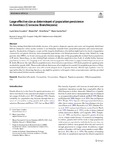Mostrar o rexistro simple do ítem
Large Effective Size as Determinant of Population Persistence in Anostraca (Crustacea: Branchiopoda)
| dc.contributor.author | Sainz-Escudero, Lucía | |
| dc.contributor.author | Vila, Marta | |
| dc.contributor.author | Perea, Silvia | |
| dc.contributor.author | García-París, Mario | |
| dc.date.accessioned | 2024-01-30T16:40:13Z | |
| dc.date.available | 2024-01-30T16:40:13Z | |
| dc.date.issued | 2023-05-26 | |
| dc.identifier.citation | Sainz-Escudero, L., Vila, M., Perea, S. et al. Large effective size as determinant of population persistence in Anostraca (Crustacea: Branchiopoda). Conserv Genet 24, 675–692 (2023). https://doi.org/10.1007/s10592-023-01534-1 | es_ES |
| dc.identifier.issn | 1572-9737 | |
| dc.identifier.uri | http://hdl.handle.net/2183/35242 | |
| dc.description.abstract | [Abstract] The fairy shrimp Branchinectella media, because of its passive dispersal capacity and scarce and irregularly distributed habitats (temporary saline aquatic systems), is an intriguing organism from a population genomics and conservation perspective. Stochasticity of dispersal events and the irregular distribution of its habitat might lead to low levels of population connectivity and genetic diversity, and consequently, populations with limited persistence through time. Indeed, by using genomic data (SNPs), we found a strong genetic structure among some of the geographically isolated Iberian populations of B. media. Interestingly, we also obtained high estimates of effective population sizes. Lack of suitable habitat between populations (absence of a “stepping stone” network) and strong genetic differentiation suggest limited dispersal success in B. media. However, the high effective population sizes observed ensure persistence of B. media populations against genetic stochasticity (genetic drift). These results indicate that rescue-effect might not be essential for population persistence if they maintain high effective population sizes able to hold adequate levels of genetic diversity. Should high population sizes be reported in other low dispersing Anostraca, one might be optimistic with regard to their conservation status and fate, provided that their natural habitats remain undisturbed. | es_ES |
| dc.description.sponsorship | Open Access funding provided thanks to the CRUE-CSIC agreement with Springer Nature. This work was supported by the “Doctorado Industrial” grant ((IND2018/AMB9692). LS-E has received research support from Comunidad Autónoma de Madrid (Spain), Fundación Global Nature and MITECO (Ministerio para la Transición Ecológica y Reto Demográfico) | es_ES |
| dc.description.sponsorship | Comunidad Autónoma de Madrid; IND2018/AMB9692 | es_ES |
| dc.language.iso | eng | es_ES |
| dc.publisher | Springer | es_ES |
| dc.relation.uri | https://doi.org/10.1007/s10592-023-01534-1 | es_ES |
| dc.rights | Atribución 4.0 Internacional | es_ES |
| dc.rights.uri | http://creativecommons.org/licenses/by/4.0/ | * |
| dc.subject | Branchinectella media | es_ES |
| dc.subject | Connectivity | es_ES |
| dc.subject | Conservation | es_ES |
| dc.subject | Dispersal | es_ES |
| dc.subject | Population genomics | es_ES |
| dc.subject | Effective population size | es_ES |
| dc.title | Large Effective Size as Determinant of Population Persistence in Anostraca (Crustacea: Branchiopoda) | es_ES |
| dc.type | info:eu-repo/semantics/article | es_ES |
| dc.rights.access | info:eu-repo/semantics/openAccess | es_ES |
| UDC.journalTitle | Conservation Genetics | es_ES |
| UDC.volume | 24 (2023) | es_ES |
| UDC.issue | 6 (December) | es_ES |
| UDC.startPage | 675 | es_ES |
| UDC.endPage | 692 | es_ES |
| dc.identifier.doi | 10.1007/s10592-023-01534-1 |
Ficheiros no ítem
Este ítem aparece na(s) seguinte(s) colección(s)
-
GI-GIBE - Artigos [74]






